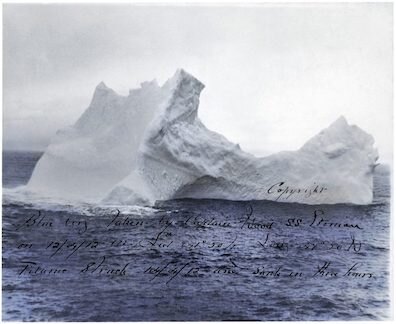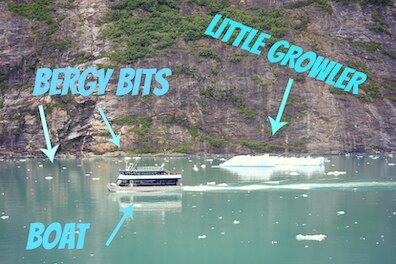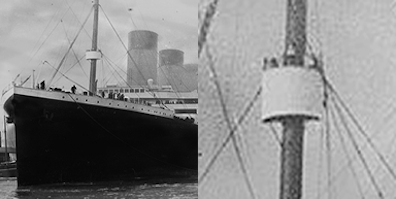Icebergs
Icebergs
In Brief
In Eumaeus, a chapter filled with allusions to
shipwrecks, frequent mentions of ice are perhaps the first
clue that Joyce may be evoking the sinking of a famous Irish
vessel in April 1912. A reference, about halfway through the
chapter, to "collisions with icebergs" certainly strengthens
this hypothesis.
Read More
Although no one in 1904 could have known of the wreck of the Titanic—that imposing product of the Belfast shipyards had not yet been built—Senan Molony argues, in an unpublished paper presented to the summer 2019 Trieste Joyce School, that echoes of the disaster permeate the 16th chapter of Ulysses. Joyce sprinkles these echoes into his text lightly, Molony observes: "he is too fine and disciplined a writer to spoil the subtlety of his craft with a heavy hand. Therefore the Titanic influences are not so ill-mannered as to be explicit, but are instead part of Joyce's mood-tonality, his artistic pointillism, which builds up the form and shape of the overall from hundreds, or even thousands, of pieces of verbal mosaic."
As Stephen and Bloom approach the cabman's shelter early in the chapter, "Adjacent to the men's public urinal they perceived an icecream car round which a group of presumably Italians in heated altercation were getting rid of voluble expressions." In Irish cities low-class eateries and street food vendors often begin business at the end of the work day and stay open into the wee hours, so encountering such a cart after midnight would not by itself be unusual. But an ice cream cart, on a day whose morning began quite chilly and which has seen a torrential rainstorm in the late evening? Perhaps so, but the detail seems at least mildly surprising. Less than half a page later, the two men have stepped into the shelter and Bloom suggests, "to break the ice," that Stephen might want to consider having a bite to eat. The expression is perfectly commonplace, but ice has now twice been insinuated into a reader's sensorium.
When Skipper Murphy begins to command the conversation, he
steers the imagery in a nautical direction: "I seen
icebergs plenty, growlers." Growlers are very small
bergs which get their name from the animal-like sounds they
can emit as their ice melts. Since they project no more than a
meter or two above the surface of the water, they are easy for
lookouts to miss, especially at night or in foggy conditions,
and many experienced seamen have speculated that the Titanic
must have struck one of these small bergs. Traveling at
considerable speed, as the big liner apparently was, hitting
the more massive slab of ice that lay underneath such a berg
(seven eighths of the total mass) would have been like hitting
a large jagged rock below the waterline. Interestingly, the
people in Eumaeus have much to say about rocks
sticking out of the water. Bloom asks Murphy if he has "seen
the rock of Gibraltar." Pressed for details, the old
salt growls, "I'm tired of all them rocks in the sea."
The keeper of the shelter wants to know "why that ship ran
bang against the only rock in Galway bay when the Galway
harbour scheme was mooted by a Mr Worthington."
The unobtrusive iceberg theme rises unmistakably above the
surface of the text when the people in the shelter begin
talking about maritime accidents: "Interest, however, was
starting to flag somewhat all round and the others got on to
talking about accidents at sea, ships lost in a fog, collisions
with icebergs, all that sort of thing." But Molony also
notes much more subtle appearances. When Murphy displays his
animated tattoo of his companion Antonio, he remarks that he
died at sea: "Ay, ay, sighed the sailor, looking down
on his manly chest. He's gone too. Ate by sharks after. Ay,
ay." "Eaten alive?" someone asks. "Ay, ay, sighed again
the latter personage, more cheerily this time." Read aloud,
"Ay sighed" may subliminally suggest the Ice Side that ate the
Titanic alive.
Near the chapter's end, as Bloom leads Stephen through the
city streets, the narrative notes that he "was keeping a
sharp lookout as usual," and he jokes to his companion,
"Our lives are in peril tonight." Molony observes that
the men posted on the Titanic's masts were ordered to
"keep a sharp lookout for small ice." Several sentences later,
Bloom expresses regret that he does not have anything to feed
the street-sweeper's horse, as he has fed gulls and a dog
earlier in the day: "such a good poor brute, he was sorry he
hadn't a lump of sugar but, as he wisely reflected,
you could scarcely be prepared for every emergency that
might crop up." Holding a lump of sugar up to a horse
bears a clear visual resemblance to a small block of ice
approaching a large ship, and describing it as an "emergency"
that might "crop up" fits very neatly with the theme.
Molony's reading of Eumaeus addresses many other
details, including the characterizations of Murphy and of the
street-sweeping horse
at the end of the chapter.



